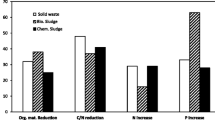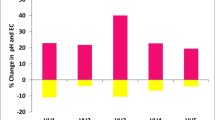Abstract
Animal fleshing (ANFL) generated as solid waste from tannery industries was vermicomposted using the epigeic earthworm Eisenia foetida. The mixing ratio of ANFL with cow dung and agricultural residues as feed mixtures was maintained to be 3:1:1 respectively during the vermicomposting experiments for 50 days. Vermicomposting resulted in the reduction of pH 6.74 and C:N ratio 15.5 compared to the control sample. A notable increase in earthworm biomass was also observed in the vermin bioreactor. The germination index of 84% for tomato seedlings (Lycopersicon esculentum cv. PKM1) was observed for the vermicomposted soil. Scanning electron microscope and Fourier transform infrared spectroscopy were recorded to identify the changes in surface morphology and functional groups in the control and vermicomposted samples. The results obtained from the present study indicated that the earthworm E. foetida was able to convert ANFL into nutrient-enriched products.


Similar content being viewed by others
References
Gopikrishna Warrier, S. Fleshing no more a waste 2001. Available from: www.hindu.com/businessline. Accessed September 10, 2001.
Ramasami, T., & Ranganayaki, M. D. (2001). Technologies for value realization of carcass by products in developing countries—a hand book. Chennai: Central Leather Research Institute (C.L.R.I).
Vasudevan, N., & Ravindran, A. D. (2007). Current Science, 93, 1492–1494.
Mata-Alvarez, J. (2002). Biomethanization of the organic fraction of municipal solid wastes. London: IWA.
Suthar, S. (2006). Bioresource Technology, 97, 2474–2477.
Garg, P., Gupta, A., & Satya, S. (2005). Bioresource Technology, 97, 391–395.
Gupta, R., & Garg, V. K. (2007). Journal of Hazardous Materials. DOI 10.1016/j.jhazmat.2007.09.055.
Marsh, L., Subler, S., Mishra, S., & Marini, M. (2004). Bioresource Technology, 96, 413–418.
Kaushik, P., & Garg, V. K. (2004). Bioresource Technology, 94, 203–209.
Kaviraj, & Sharma, S. (2003). Bioresource Technology, 90, 169–173.
Banu, J. R., Esakkiraj, S., Nagendran, R., & Logakanthi, S. (2005). Journal of Environmental Biology, 26(1), 43–47.
Vigueros, L. C., & Ramírez Camperos, E. (2002). Water Science Technology, 46(10), 153–158.
Arancon, N. Q., Edwards, C. A., Babenko, A., Cannon, J., Galvis, P., & Metzger, J. D. (2008). Applied Soil Ecology, 39, 91–99.
Gajalakshmi, S., & Abbasi, S. A. (2003). Bioresource Technology, 2, 613–615.
Ndegwa, P. M., & Thompson, S. A. (2001). Bioresource Technology, 76, 107–112.
Zerdani, I., Faid, M., & Malki, A. (2004). International Journal of Agriculture & Biology, 65, 758–761.
Annapurna Raju, A., Rose, C., & Muralidhara Rao, N. (1997). Animal Feed Science and Technology, 66, 139–147.
American Public Health Association, American Water Works Association, Water Pollution Control Federation (1989). Standard methods for the examination of water and wastewater (17th ed.). Washington, DC: APHA.
McKeague, J. A. (1981). Manual on soil sampling and methods of analysis (2nd ed.). Ottawa: Canadian Society of Soil Science.
Walkey, A., & Black, C. A. (1934). Soil Science, 37, 29–38.
Bremner, J. M. (1996). Nitrogen—total. In D. L. Sparks (Ed.), Methods of soil analysis. Part 3—chemical methods (pp. 1085–1121). Madison: Soil Science Society of America and American Society of Agronomy.
Kaushik, P., & Garg, V. K. (2003). Bioresource Technology, 90, 311–316.
Mathur, S. P., Owen, G., Dinel, H., & Schnitzer, M. (1993). Biological Agriculture and Horticulture, 10, 65–85.
Ndegwa, P. M., Thompson, S. A., & Das, K. C. (2000). Bioresource Technology, 71, 5–12.
Wong, J. M. C., Fang, M., Li, G. X., & Wong, M. H. (1997). Environmental Technology, 18, 563–568.
Suthar, S., & Sushma, S. (2008). Science of the Total Environment. DOI 10.1016/j.scitotenv.2008.02.005.
Tripathi, G., & Bhardwaj, P. (2004). Bioresource Technology, 92, 275–283.
Garg, V. K., Kaushik, P., & Neeraj, D. (2006). Ecotoxicology and Environmental Safety, 65, 412–419.
Bernal, M. P., Navarro, A. F., Roig, A., Cegarra, J., & Garcia, D. (1996). Biology and Fertility of Soils, 22, 141–148.
Contreras-Ramos, S. M., Alvarez-Bernal, D., Trujillo-Tapia, N., & Dendooven, L. (2004). Bioresource Technology, 94, 223–228.
Biswarup, S., & Chandra, T. S. (2007). Bioresource Technology, 98, 1680–1683.
Grube, M., Lin, J. G., Lee, P. H., & Kokorevicha, S. (2006). Geoderma, 130, 324–333.
Author information
Authors and Affiliations
Corresponding author
Rights and permissions
About this article
Cite this article
Ravindran, B., Dinesh, S.L., Kennedy, L.J. et al. Vermicomposting of Solid Waste Generated from Leather Industries Using Epigeic Earthworm Eisenia foetida . Appl Biochem Biotechnol 151, 480–488 (2008). https://doi.org/10.1007/s12010-008-8222-3
Received:
Accepted:
Published:
Issue Date:
DOI: https://doi.org/10.1007/s12010-008-8222-3




